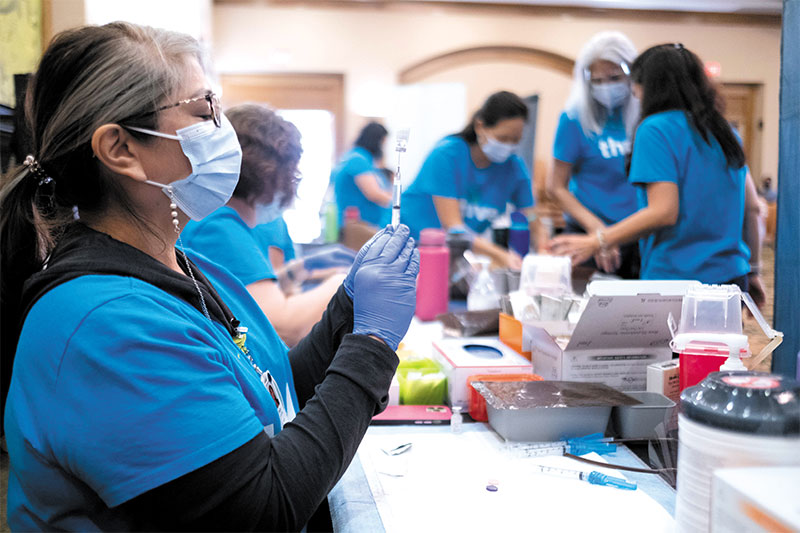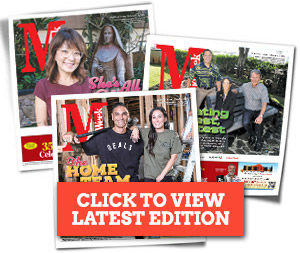Hail To The Frontline
Each day, and especially during Nurses Week, Kaiser Permanente Hawai‘i honors its brave frontline health care workers such as Corrina Ibanez, Kimberly Gibu and Dionicia Lagapa, who have led the organization’s expansive COVID vaccination efforts throughout the state.
For decades, the country has commemorated National Nurses Week (May 6-12) as a way to honor the real-life superheroes who show up day in and day out — humbly and without hesitation — and this year is certainly no different. While most of the world was shut down, learning TikTok dances and cooking viral pasta recipes, hospitals and the hardworking people within them experienced quite the opposite.
“We were in the heart of a pandemic with most of America and the whole world, who had never experienced this, so it was uncharted territory for all of us,” says Dionicia Lagapa, MS, APRN, director, clinic operations for Kaiser Permanente Hawai‘i.
“People shut down, they went virtual, they stayed home, but we … ramped up. We were front and center, we were there seven days a week to care for any members who came through the door. It was a very tough, challenging and long year to see people get sick, and also to keep our family members and us from getting sick. There were a lot of separations and hours without each other because we had to ensure that we all had to stay safe.”

An assemblage of Marshallese COVID-19 Task Force members and Kaiser Permanente Hawai‘i staffers, including (from left) Kimberly Gibu, Meno Bolkeim, Kelly Gideon, Dr. Wilfred Alik, Isabella Silk and Paul Jendrikdrik.
When word got around late fall that vaccines were on the horizon, tidal waves of relief washed over those who experienced the very worst of it all. The initial round went to frontline health care workers, and when one of the first employees — an infectious disease physician — sat in the chair, Lagapa will always remember the look on her face.
“She had definitely seen the worst of the worst, and I remember her saying to me, ‘I have to call my mom after this,’” Lagapa says. “It was so emotional because it was such a tough year to watch people succumb to this disease, get ill, watch families get separated. The frontline workers in the organization I work for worked tirelessly during this pandemic and to see their expressions of hope and gratitude was just priceless. It made it so rewarding and seemed like there was a light at the end of the tunnel.”
Though the past several months have been some of the most grueling for nurses, Lagapa — who spearheaded much of Kaiser’s coronavirus efforts with grace, kindness and calm, according to her colleagues — says it’s been rewarding, too.
“In all the years I have been here, this organization has been wonderful for me, personally and professionally, and I know a lot of nurses feel that. So, when it was time to roll up our sleeves, no one thought twice about it,” she says. “A lot of people came in on the weekends or volunteered in the community and said, ‘I’ll take that shift.’ I would not change my career in a heartbeat, nor the company that I work for.”
Once it was time to roll out vaccines to the public, Kaiser was more than prepared, thanks to Corrina Ibanez, RN, BSN, and her multidisciplinary team of nursing leaders, pharmacy partners, doctors, allergists and many others. Together, they created a toolkit that serves as a one-stop shop for every little thing one needs to know about administering the inoculations, setting the foundation for Kaiser’s clinics that now span from Kapa‘a to Kona.
“Everyone, I mean everyone, leaned in and was willing to pitch in where needed to ensure that we’re not just vaccinating — but vaccinating safely,” says Ibanez.
The group leveraged technology, as well as workflows and processes from previous mass vaccination clinics for the flu and hepatitis A, and utilized each department’s strengths to scale the efforts to where it is today.

Grace Quidilla, MSN, RN, prepares a COVID-19 vaccine at Kaiser Permanente Hawai‘i’s pop-up event, held at Waipahu’s Filipino Community Center.
“Now, that wasn’t an easy feat,” Ibanez says with a laugh. “The thought process itself is pretty similar to any vaccination; there’s education, questionnaires and consent forms. However, with the COVID vaccines, there’s just a lot of steps to ensure that the vaccine is still viable.”
The delicate vials must be kept in ultra-low temperatures — for this, Kaiser had to purchase a special storage freezer — protected from light, and some brands need to be diluted, while others do not. On top of this, flying the vaccines to the neighbor islands was another hurdle to jump.
“It was probably one of my biggest challenges, identifying this whole cold chain management because the last thing we want to do is waste vaccines,” explains Ibanez, who is the clinic manager of Kaiser’s Waipi‘o Medical Office. “Another component to
this is that once you puncture the vial, you need to look for other arms to make sure you don’t waste. It’s a big shout-out to our pharmacy team, who played a significant part in making sure our neighbor islands got the vaccine.”
Considering that each region has its own advantages and challenges, the toolkit is “a living and breathing document,” according to Ibanez.
“I started ‘version one’ many moons ago and it morphed as I worked with partners on the Big Island, Kaua‘i, Maui and on O‘ahu, and everyone chimed in and we have revamped and edited and made adjustments to this toolkit. We are currently on ‘version 20,’” she says with a smile.
“This will always be a work in progress. COVID is so brand new, so I can see this continuing to grow. As we heard last week on the news, we may need boosters now, so this will continue to morph and grow with us, and we’re going to make adjustments to get ahead of this.”
For some, getting a vaccination appointment was as simple as filling out a form online. However, it wasn’t like that for everyone. Recognizing this, Kaiser’s nurses went out into underserved communities, bringing everything with them from gloves and sanitization to Wi-Fi, industrial fans and flashlights, in some cases.
“We started off partnering with Native Hawaiian communities for their kūpuna, and we branched out to help with public housing and rural areas in the outer islands, as well as longline fishermen,” says Kimberly Gibu, MSN, RN, senior manager for care delivery with Kaiser Permanente Hawai‘i. “We’re seeing people from all walks of life, and they’re just so grateful and happy to be there. They told us that if we didn’t come, there was no way they could’ve gotten the vaccine.
“Every time we go to those events, they’re busy, stressful and exhausting, but when you leave, you have that sigh of relief, like, ‘Yeah, we did good today. We made a difference,’” she says.
These pop-up clinics — which were held in community centers, warehouses, a basketball gym and even a pingpong room — were made possible thanks to community organizations that supplied a location and helped spread the news.
“The coconut wireless is powerful,” Gibu chuckles.
“For me, it all boils down to doing the right thing,” she continues. “Kaiser is all about trying to promote equity, diversity and inclusion, especially in health care. It’s our obligation to the community to provide that care to them.
“I work with such a great team, who is passionate about this type of work and we just have fun with it. It fills our soul and it’s just so satisfying that we get to do this; it’s an honor.”








